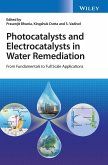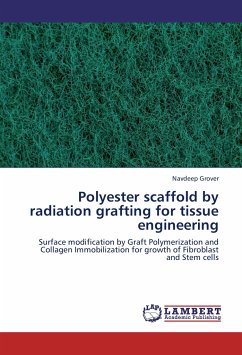Self-Assembled Carbon Scaffold-based Photocatalysts
Environmental and Industrial Applications
Herausgegeben:Oraon, Ramesh; Singh, Pardeep; Sillanpaa, Mika; Nayak, Ganesh Chandra
Self-Assembled Carbon Scaffold-based Photocatalysts
Environmental and Industrial Applications
Herausgegeben:Oraon, Ramesh; Singh, Pardeep; Sillanpaa, Mika; Nayak, Ganesh Chandra
- Gebundenes Buch
- Merkliste
- Auf die Merkliste
- Bewerten Bewerten
- Teilen
- Produkt teilen
- Produkterinnerung
- Produkterinnerung
The book discusses the advantages, potential applications and current industrial applications of carbon scaffold-based nano photocatalysts. It covers the necessary fundamentals, mechanisms and computations on catalytic activity to introduce and discuss energy, industrial and environmental applications to supply the reader with a full understanding of the topic.
Andere Kunden interessierten sich auch für
![Nanosistemi polisaccaridici intelligenti come scaffold per l'ingegneria tissutale Nanosistemi polisaccaridici intelligenti come scaffold per l'ingegneria tissutale]() V. Sugantha KumariNanosistemi polisaccaridici intelligenti come scaffold per l'ingegneria tissutale23,99 €
V. Sugantha KumariNanosistemi polisaccaridici intelligenti come scaffold per l'ingegneria tissutale23,99 €![Metodologie di sintesi Scaffold privilegiati biologicamente rilevanti Metodologie di sintesi Scaffold privilegiati biologicamente rilevanti]() Lorenzo BottaMetodologie di sintesi Scaffold privilegiati biologicamente rilevanti36,99 €
Lorenzo BottaMetodologie di sintesi Scaffold privilegiati biologicamente rilevanti36,99 €![Semiconductor Solar Photocatalysts Semiconductor Solar Photocatalysts]() Semiconductor Solar Photocatalysts182,00 €
Semiconductor Solar Photocatalysts182,00 €![Photocatalysts and Electrocatalysts in Water Remediation Photocatalysts and Electrocatalysts in Water Remediation]() Photocatalysts and Electrocatalysts in Water Remediation164,99 €
Photocatalysts and Electrocatalysts in Water Remediation164,99 €![Carbon-Based Smart Materials Carbon-Based Smart Materials]() Carbon-Based Smart Materials127,99 €
Carbon-Based Smart Materials127,99 €![Polyester scaffold by radiation grafting for tissue engineering Polyester scaffold by radiation grafting for tissue engineering]() Navdeep GroverPolyester scaffold by radiation grafting for tissue engineering52,99 €
Navdeep GroverPolyester scaffold by radiation grafting for tissue engineering52,99 €![Designing of nano Photocatalysts For Removal of organic pollutions Designing of nano Photocatalysts For Removal of organic pollutions]() Roya Mohammadzadeh KakhkiDesigning of nano Photocatalysts For Removal of organic pollutions53,99 €
Roya Mohammadzadeh KakhkiDesigning of nano Photocatalysts For Removal of organic pollutions53,99 €-
-
-
The book discusses the advantages, potential applications and current industrial applications of carbon scaffold-based nano photocatalysts. It covers the necessary fundamentals, mechanisms and computations on catalytic activity to introduce and discuss energy,
industrial and environmental applications to supply the reader with a full understanding of the topic.
industrial and environmental applications to supply the reader with a full understanding of the topic.
Produktdetails
- Produktdetails
- Verlag: Wiley-Vch; Wiley
- Artikelnr. des Verlages: 1135397 000
- Seitenzahl: 350
- Erscheinungstermin: 22. April 2026
- Englisch
- Abmessung: 244mm x 170mm
- ISBN-13: 9783527353972
- ISBN-10: 3527353976
- Artikelnr.: 75604732
- Herstellerkennzeichnung
- Wiley-VCH GmbH
- Boschstraße 12
- 69469 Weinheim
- wiley-vch@kolibri360.de
- Verlag: Wiley-Vch; Wiley
- Artikelnr. des Verlages: 1135397 000
- Seitenzahl: 350
- Erscheinungstermin: 22. April 2026
- Englisch
- Abmessung: 244mm x 170mm
- ISBN-13: 9783527353972
- ISBN-10: 3527353976
- Artikelnr.: 75604732
- Herstellerkennzeichnung
- Wiley-VCH GmbH
- Boschstraße 12
- 69469 Weinheim
- wiley-vch@kolibri360.de
Dr. Ramesh Oraon is presently working as Assistant Professor at the Central University of Jharkhand, Ranchi, Jharkhand, India. He obtained his doctorate degree from IIT (ISM) Dhanbad, Department of Chemistry, in 2017. The area of his doctoral research is the development of nano clay-based hybrid electrode materials for application in supercapacitors. He has published 25 papers and 5 book chapters in the Internationally reputed journals of and related areas/reputed publishers. His current research projects are ?Development of carbonaceous/metal oxide/conducting polymerbased hybrid electrode materials and their electrochemical study? and ?Development of organic-inorganic based hybrid electrode materials: Towards supercapacitor and Sensors?. He is a subject expert in synthesis, functionalization, characterization of carbon materials, metal oxides, Conducting polymers and their electrochemical analysis of applications in energy storage, sensors etc. Dr. Ganesh Chandra Nayak is presently working as Associate Professor at IIT (ISM) Dhanbad Dept. of Chemistry and chemical biology India. He obtained his doctorate degree from IIT Kharagpur in the year 2012. Current area of his research includes Energy Storage, Microwave Absorption, Nanoparticle Synthesis and applications. He has published more than 40 papers in the Internationally reputed journals of and related areas/reputed publishers. Dr Pardeep Singh is presently working as senior Assistant professor (Department of Environmental Science PGDAV College University of Delhi New Delhi, India. Having an h-index 21 his publications have been cited over 1650 Google scholar. He has published more than 65 papers and edited 35 books with an international publisher in the fields of waste management. Professor Mika Sillanpää received his M.Sc. (Eng.) and D.Sc. (Eng.) from the Aalto University, Finland. Having an h-index of 95, his publications have been cited over 46 000 times (Google Scholar). Mika Sillanpää has received numerous awards for research and innovation. Among these, he is the first Laureate of Scientific Committee on the Problems of the Environment (SCOPE)?s Young Investigator Award. In 2017?2020, he has been listed as a Highly Cited Researcher by Thomson Reuters. In 2018, he was invited to become a Member of the Finnish Academy of Sciences and Letters and Academy of Technical Sciences.
SECTION I: Fundamental Insight & Novelty
1. Nanophotocatalysts: Fundamentals, Mechanisms and advances in remediation
technologies,
2. Photocatalytic activity: Computational Estimation, optimisation and
Degradation processes.
3. Carbon scaffold-based Novel nano photocatalysts: Industrial Synthesis,
degradation mechanism & sustainability.
4. Industrial Effluents, their degradation chemistry and Market economics.
SECTION II: Remediations & Ecological Aspects
5. Magnetic nano photocatalysts for environmental remediations:
Implications and Prospects
6. Persistent pollutants in the biosphere and their remediations through
Carbon scaffold-based nano photocatalysts: Developments and Challenges
7. Waste management through Carbon scaffold-based Nanophotocatalysis:
Trends and Ecological impact
SECTION III: Industrial Implications & Energy Economics
8. Carbon scaffold-based Nanophotocatalysts for sustainable energy:
Industrial implementation and their socio-economic impact.
9. Carbon scaffold-based Nano-photocatalysts in semiconductors:
Fabrication, Performance and Prospects
10. Nanophotocatalysts in Hydrogen and Methane Production: Strategies and
Challenges.
11. Nano-photocatalysts in water splitting and fuel production: Mechanism,
Functionalisation, Challenges and Prospects
12. Industry economics for Carbon scaffold-based nano photocatalysts: Past,
present and the Prospects
1. Nanophotocatalysts: Fundamentals, Mechanisms and advances in remediation
technologies,
2. Photocatalytic activity: Computational Estimation, optimisation and
Degradation processes.
3. Carbon scaffold-based Novel nano photocatalysts: Industrial Synthesis,
degradation mechanism & sustainability.
4. Industrial Effluents, their degradation chemistry and Market economics.
SECTION II: Remediations & Ecological Aspects
5. Magnetic nano photocatalysts for environmental remediations:
Implications and Prospects
6. Persistent pollutants in the biosphere and their remediations through
Carbon scaffold-based nano photocatalysts: Developments and Challenges
7. Waste management through Carbon scaffold-based Nanophotocatalysis:
Trends and Ecological impact
SECTION III: Industrial Implications & Energy Economics
8. Carbon scaffold-based Nanophotocatalysts for sustainable energy:
Industrial implementation and their socio-economic impact.
9. Carbon scaffold-based Nano-photocatalysts in semiconductors:
Fabrication, Performance and Prospects
10. Nanophotocatalysts in Hydrogen and Methane Production: Strategies and
Challenges.
11. Nano-photocatalysts in water splitting and fuel production: Mechanism,
Functionalisation, Challenges and Prospects
12. Industry economics for Carbon scaffold-based nano photocatalysts: Past,
present and the Prospects
SECTION I: Fundamental Insight & Novelty
1. Nanophotocatalysts: Fundamentals, Mechanisms and advances in remediation
technologies,
2. Photocatalytic activity: Computational Estimation, optimisation and
Degradation processes.
3. Carbon scaffold-based Novel nano photocatalysts: Industrial Synthesis,
degradation mechanism & sustainability.
4. Industrial Effluents, their degradation chemistry and Market economics.
SECTION II: Remediations & Ecological Aspects
5. Magnetic nano photocatalysts for environmental remediations:
Implications and Prospects
6. Persistent pollutants in the biosphere and their remediations through
Carbon scaffold-based nano photocatalysts: Developments and Challenges
7. Waste management through Carbon scaffold-based Nanophotocatalysis:
Trends and Ecological impact
SECTION III: Industrial Implications & Energy Economics
8. Carbon scaffold-based Nanophotocatalysts for sustainable energy:
Industrial implementation and their socio-economic impact.
9. Carbon scaffold-based Nano-photocatalysts in semiconductors:
Fabrication, Performance and Prospects
10. Nanophotocatalysts in Hydrogen and Methane Production: Strategies and
Challenges.
11. Nano-photocatalysts in water splitting and fuel production: Mechanism,
Functionalisation, Challenges and Prospects
12. Industry economics for Carbon scaffold-based nano photocatalysts: Past,
present and the Prospects
1. Nanophotocatalysts: Fundamentals, Mechanisms and advances in remediation
technologies,
2. Photocatalytic activity: Computational Estimation, optimisation and
Degradation processes.
3. Carbon scaffold-based Novel nano photocatalysts: Industrial Synthesis,
degradation mechanism & sustainability.
4. Industrial Effluents, their degradation chemistry and Market economics.
SECTION II: Remediations & Ecological Aspects
5. Magnetic nano photocatalysts for environmental remediations:
Implications and Prospects
6. Persistent pollutants in the biosphere and their remediations through
Carbon scaffold-based nano photocatalysts: Developments and Challenges
7. Waste management through Carbon scaffold-based Nanophotocatalysis:
Trends and Ecological impact
SECTION III: Industrial Implications & Energy Economics
8. Carbon scaffold-based Nanophotocatalysts for sustainable energy:
Industrial implementation and their socio-economic impact.
9. Carbon scaffold-based Nano-photocatalysts in semiconductors:
Fabrication, Performance and Prospects
10. Nanophotocatalysts in Hydrogen and Methane Production: Strategies and
Challenges.
11. Nano-photocatalysts in water splitting and fuel production: Mechanism,
Functionalisation, Challenges and Prospects
12. Industry economics for Carbon scaffold-based nano photocatalysts: Past,
present and the Prospects








